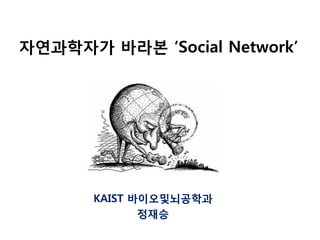мІҙмқём§ҖмҳЁ м •мһ¬мҠ№
- 1. мһҗм—°кіјн•ҷмһҗк°Җ л°”лқјліё вҖҳSocial NetworkвҖҷ KAIST л°”мқҙмҳӨл°ҸлҮҢкіөн•ҷкіј м •мһ¬мҠ№
- 2. Paul Erdos: Erdos Numbers
- 3. мјҖл№Ҳ лІ мқҙм»Ёмқҳ м—¬м„Ҝ лӢЁкі„ кІҢмһ„ (Six degrees of Kevin Bacon)
- 6. Small world network Bullmore and Sporns, 2009
- 9. ZipfвҖҷs Law George Zipf's 1949 observation that the frequency of words used in the English language followed a powerlaw distribution is a profound thing. It not only defined вҖҳZipf's LawвҖҷ, which gives a simple rule to explain why some words (e.g. the, of, and) are far more commonly used than others.
- 10. The scale-free nature of the web of sexual contacts. вҖў They analyze data gathered in a 1996 Swedish survey of sexual behavior. The survey--involving a random sample of 4781 Swedish individuals (ages 18-74 yr)-- used structured personal interviews and questionnaires to collect information. вҖў The response rate was 59 percent, corresponding to 2810 respondents. Connections in the network of sexual contacts appear and disappear as sexual relations are initiated and terminated. вҖў To analyze the connectivity of this dynamic network, whose links may be quite short lived, we first analyze the number k of sex partners over a relatively short time window--the twelve months prior to the survey.
- 12. 1. Introduction : Self-Organization - A process of attraction and repulsion in which the internal organization of a system, normally an open system, increases in complexity without being guided or managed by an outside source (From Wikipedia) - Typically displays Emergent Properties Self-Organized Criticality: The origin of 1/f in the Brain
- 13. Complex Systems вҖў Nonlinear basic unit/individual вҖў Nonlinear interactions among units вҖў Complex and ordered structures вҖў Intrinsic stochastic noises вҖў Dynamical transition of the states вҖў Rich phenomena: chaos, fractal, small-world effect, scale-free behavior, intermittency, bursting, and synchronization. вҖў Dynamical adaptation! вҖў Wake from your reverie вҖңhomeostasis and stability.вҖқ вҖў Focus on the complexity of the system! вҖў Only a short-term prediction is possible. вҖў Interdisciplinary research will be more preferable and useful.
- 14. Complex dynamics of heart rate variability
- 15. Breakdown of a fractal physiological control mechanism can lead ultimately either to a highly periodic output dominated by a single scale or to uncorrelated randomness.
- 16. African Fractal
- 18. Hub and connectors vs. Weak ties
- 19. Collective Intelligence вҖў м—¬лҹ¬ мӮ¬лһҢл“Өмқҙ н•Ёк»ҳ л¬ём ңлҘј н•ҙкІ°н•ҳкі , м„ңлЎң мқҳкІ¬мқ„ кіөмң н•ҳл©°, к°Ғмһҗ мһҗмӢ мқҙ к°Җ진 кІғмқ„ кё°м—¬н•ҳкі м°ём—¬н•ҳл©°, м„ңлЎң ліҙмҷ„н•ҳлҠ” м •мӢ (м°ём—¬, кіөмң , к°ңл°©).
- 20. Suggestions вҖў Social network мқҖ complex systems мқҳ м „нҳ•м Ғмқё мҳҲ мӨ‘ н•ҳлӮҳ лӢӨ. Complex network мқҳ м°Ҫл°ңм„ұмқ„ нҷңмҡ©н•ҳмһҗ! вҖў кіөкіөмә нҺҳмқёмқ„ мң„н•ҙ Worldwide Web, Blogosphere л“ұмқ„ м Ғк·№ м ҒмңјлЎң нҷңмҡ©н•ҳмһҗ! вҖў Diffusion of Buzz: л§Өл Ҙм Ғмқё л°”мқҙлҹ¬мҠӨлҘј л§Ңл“Өмһҗ! вҖў вҖҳInformation CascadeвҖҷлҘј мқҙлҒҢм–ҙлӮҙмһҗ! вҖў н—ҲлёҢмҷҖ м»Өл„Ҙн„°лҘј кіөлһөн•ҳмһҗ! вҖў вҖҳм•Ҫн•ң мң лҢҖмқҳ нһҳвҖҷмқ„ нҷңмҡ©н•ҳмһҗ! вҖў мһҗл°ңм Ғмқё м°ём—¬, кіөмң , к°ңл°©мқ„ нҷңмҡ©н•ҳмһҗ!



















